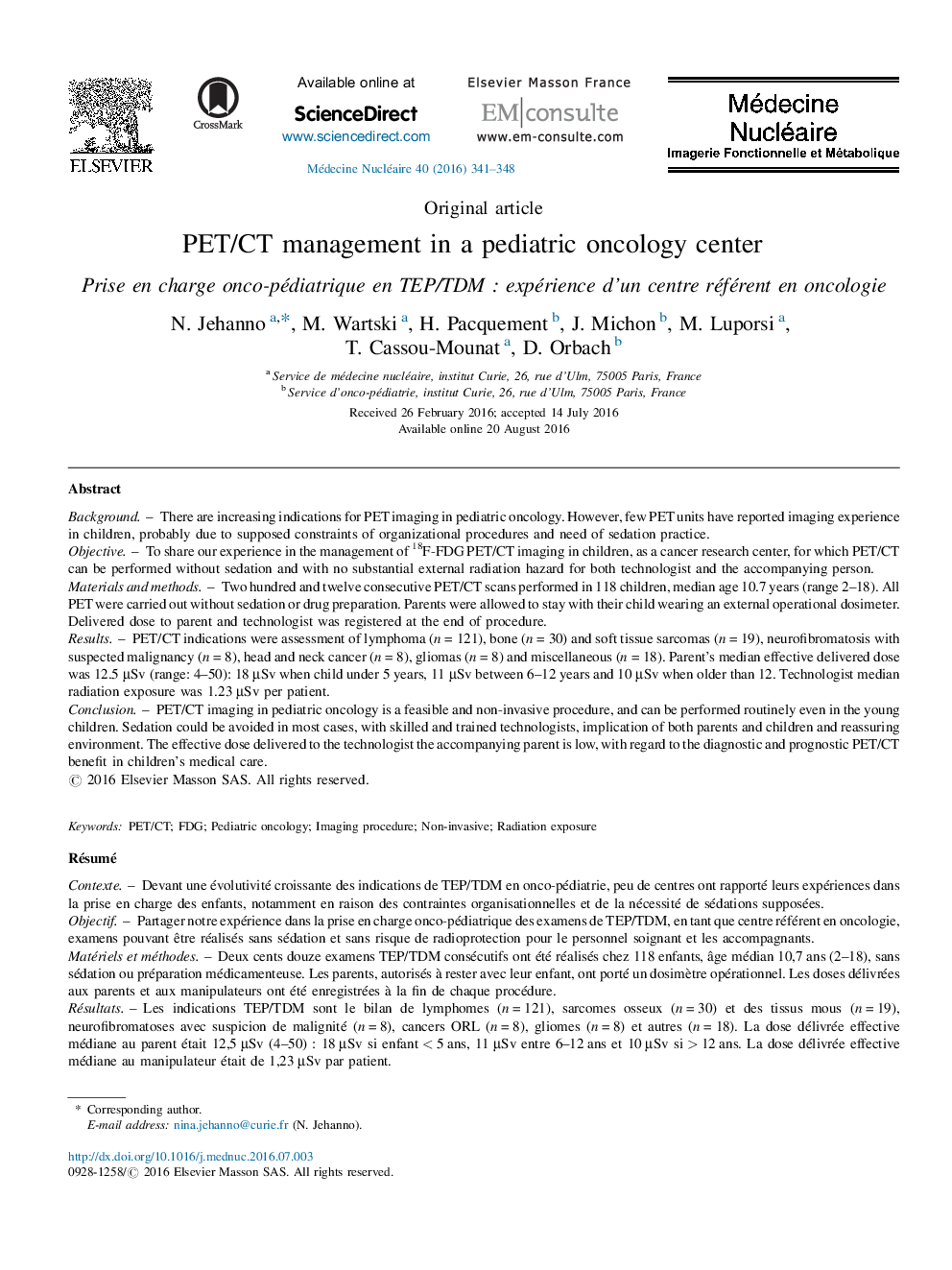| کد مقاله | کد نشریه | سال انتشار | مقاله انگلیسی | نسخه تمام متن |
|---|---|---|---|---|
| 5728018 | 1411627 | 2016 | 8 صفحه PDF | دانلود رایگان |

BackgroundThere are increasing indications for PET imaging in pediatric oncology. However, few PET units have reported imaging experience in children, probably due to supposed constraints of organizational procedures and need of sedation practice.ObjectiveTo share our experience in the management of 18F-FDG PET/CT imaging in children, as a cancer research center, for which PET/CT can be performed without sedation and with no substantial external radiation hazard for both technologist and the accompanying person.Materials and methodsTwo hundred and twelve consecutive PET/CT scans performed in 118 children, median age 10.7 years (range 2-18). All PET were carried out without sedation or drug preparation. Parents were allowed to stay with their child wearing an external operational dosimeter. Delivered dose to parent and technologist was registered at the end of procedure.ResultsPET/CT indications were assessment of lymphoma (n = 121), bone (n = 30) and soft tissue sarcomas (n = 19), neurofibromatosis with suspected malignancy (n = 8), head and neck cancer (n = 8), gliomas (n = 8) and miscellaneous (n = 18). Parent's median effective delivered dose was 12.5 μSv (range: 4-50): 18 μSv when child under 5 years, 11 μSv between 6-12 years and 10 μSv when older than 12. Technologist median radiation exposure was 1.23 μSv per patient.ConclusionPET/CT imaging in pediatric oncology is a feasible and non-invasive procedure, and can be performed routinely even in the young children. Sedation could be avoided in most cases, with skilled and trained technologists, implication of both parents and children and reassuring environment. The effective dose delivered to the technologist the accompanying parent is low, with regard to the diagnostic and prognostic PET/CT benefit in children's medical care.
RésuméContexteDevant une évolutivité croissante des indications de TEP/TDM en onco-pédiatrie, peu de centres ont rapporté leurs expériences dans la prise en charge des enfants, notamment en raison des contraintes organisationnelles et de la nécessité de sédations supposées.ObjectifPartager notre expérience dans la prise en charge onco-pédiatrique des examens de TEP/TDM, en tant que centre référent en oncologie, examens pouvant être réalisés sans sédation et sans risque de radioprotection pour le personnel soignant et les accompagnants.Matériels et méthodesDeux cents douze examens TEP/TDM consécutifs ont été réalisés chez 118 enfants, âge médian 10,7 ans (2-18), sans sédation ou préparation médicamenteuse. Les parents, autorisés à rester avec leur enfant, ont porté un dosimètre opérationnel. Les doses délivrées aux parents et aux manipulateurs ont été enregistrées à la fin de chaque procédure.RésultatsLes indications TEP/TDM sont le bilan de lymphomes (n = 121), sarcomes osseux (n = 30) et des tissus mous (n = 19), neurofibromatoses avec suspicion de malignité (n = 8), cancers ORL (n = 8), gliomes (n = 8) et autres (n = 18). La dose délivrée effective médiane au parent était 12,5 μSv (4-50) : 18 μSv si enfant < 5 ans, 11 μSv entre 6-12 ans et 10 μSv si > 12 ans. La dose délivrée effective médiane au manipulateur était de 1,23 μSv par patient.ConclusionL'imagerie TEP/TDM en onco-pédiatrie est une procédure faisable et non invasive, pouvant être réalisée en routine, y compris pour de jeunes enfants. Une équipe entraînée et rassurante, l'implication des parents et des enfants, ainsi qu'un environnement rassurant permet d'éviter la sédation. La dose effective reçue par les manipulateurs et les parents accompagnants est faible, au regard du bénéfice diagnostique et de prise en charge pour l'enfant.
Journal: Médecine Nucléaire - Volume 40, Issue 5, October 2016, Pages 341-348